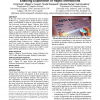Free Online Productivity Tools
i2Speak
i2Symbol
i2OCR
iTex2Img
iWeb2Print
iWeb2Shot
i2Type
iPdf2Split
iPdf2Merge
i2Bopomofo
i2Arabic
i2Style
i2Image
i2PDF
iLatex2Rtf
Sci2ools
130
click to vote
TEI
2012
ACM
2012
ACM
The HapticTouch toolkit: enabling exploration of haptic interactions
In the real world, touch based interaction relies on haptic feedback (e.g., grasping objects, feeling textures). Unfortunately, such feedback is absent in current tabletop systems. The previously developed Haptic Tabletop Puck (HTP) aims at supporting experimentation with and development of inexpensive tabletop haptic interfaces in a do-it-yourself fashion. The problem is that programming the HTP (and haptics in general) is difficult. To address this problem, we contribute the HAPTICTOUCH toolkit, which enables developers to rapidly prototype haptic tabletop applications. Our toolkit is structured in three layers that enable programmers to: (1) directly control the device, (2) create customized combinable haptic behaviors (e.g., softness, oscillation), and (3) use visuals (e.g., shapes, images, buttons) to quickly make use of these behaviors. In our preliminary exploration we found that programmers could use our toolkit to create haptic tabletop applications in a short amount of time....
Related Content
| Added | 25 Apr 2012 |
| Updated | 25 Apr 2012 |
| Type | Journal |
| Year | 2012 |
| Where | TEI |
| Authors | David Ledo, Miguel A. Nacenta, Nicolai Marquardt, Sebastian Boring, Saul Greenberg |
Comments (0)

